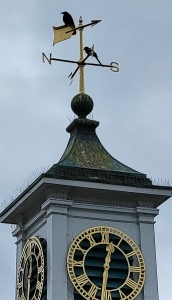Adam Yamey's Blog: YAMEY, page 81
August 1, 2023
The way the wind blows
July 31, 2023
White and nutritious – milk and racism
UNTIL I WAS ABOUT 18, I drank a pint of chilled milk in the morning and another when I came home from school. I did not drink all the varieties of milk that were supplied by the milkmen who worked for the Express Dairy Company, but chose the ‘homogenised’ variety, which did not have cream at the top of the bottle. Never once whilst drinking this refreshing slightly watery liquid did I ever imagine that I would one day visit an exhibition about milk. Today, the 29th of July 2023, I viewed an exhibition called “Milk”, which is being shown at the Wellcome Collection in London’s Euston Road until the 10th of September 2023. Amongst the numerous exhibits displayed in this beautifully curated show, the following particularly interest me.
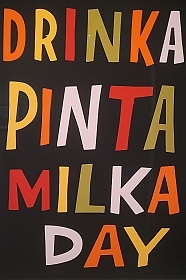 There was a collection of decorated porcelain cream jugs. Each one was shaped like a cow. Cream used to be poured into the hollow cow via a hole in its back. Then, a lid was placed to cover that orifice. To use the cream jugs, the cows were tilted so that the cream could flow out of another hole through creatures’ mouths.There was a terracotta model of a mule carrying two trays laden with cheeses. This Ancient Roman artefact dating back to the 3rd or 2nd century BC was found by archaeologists in Southern Italy. In times long before refrigeration, making cheese was one way of preserving milk for future use.I saw a metal lactometer, which was used to determine the amount of water in milk. My wife said that when she was a child in India, milk used to be delivered to the door. To check whether the milkman had watered it down, her mother used a lactometer just like the one on display at the exhibition.Our daughter spotted an 18th century etching depicting St Bernard of Clairvaux kneeling before the Virgin holding the Christ Child. As the saint knelt before the Virgin, he received a squirt of her milk from her breast. This was supposed to grant him wisdom and eloquence. When she was studying History of Art, our daughter wrote a thesis about this curious episode – The Lactation of St Bernard’.A rather uninteresting looking exhibit proved to be most fascinating. It consisted of two milk testing forms, which had to be completed after a farmer’s batch of milk had been tested for diseases, bacteria, fat content, and protein content. The forms on display related to milk produced by cattle on the Dartington Hall Estate in Devon. The Estate was founded to research the merits of various scientific farming methods. One of the founders of the Estate was the agronomist Leonard Elmhirst (1893-1974). What made him special in my mind was that after meeting the great Rabindrath Tagore (1861-1941) in the USA in 1913, he later (in 1922) set up for Tagore an Institute of Rural Reconstruction near Tagore’s university at Shantiniketan (now in West Bengal). After marrying Dorothy Straight, Elmhirst and his wife established the Estate at Dartington in 1925. It was modelled on what he had founded near Shantiniketan.
There was a collection of decorated porcelain cream jugs. Each one was shaped like a cow. Cream used to be poured into the hollow cow via a hole in its back. Then, a lid was placed to cover that orifice. To use the cream jugs, the cows were tilted so that the cream could flow out of another hole through creatures’ mouths.There was a terracotta model of a mule carrying two trays laden with cheeses. This Ancient Roman artefact dating back to the 3rd or 2nd century BC was found by archaeologists in Southern Italy. In times long before refrigeration, making cheese was one way of preserving milk for future use.I saw a metal lactometer, which was used to determine the amount of water in milk. My wife said that when she was a child in India, milk used to be delivered to the door. To check whether the milkman had watered it down, her mother used a lactometer just like the one on display at the exhibition.Our daughter spotted an 18th century etching depicting St Bernard of Clairvaux kneeling before the Virgin holding the Christ Child. As the saint knelt before the Virgin, he received a squirt of her milk from her breast. This was supposed to grant him wisdom and eloquence. When she was studying History of Art, our daughter wrote a thesis about this curious episode – The Lactation of St Bernard’.A rather uninteresting looking exhibit proved to be most fascinating. It consisted of two milk testing forms, which had to be completed after a farmer’s batch of milk had been tested for diseases, bacteria, fat content, and protein content. The forms on display related to milk produced by cattle on the Dartington Hall Estate in Devon. The Estate was founded to research the merits of various scientific farming methods. One of the founders of the Estate was the agronomist Leonard Elmhirst (1893-1974). What made him special in my mind was that after meeting the great Rabindrath Tagore (1861-1941) in the USA in 1913, he later (in 1922) set up for Tagore an Institute of Rural Reconstruction near Tagore’s university at Shantiniketan (now in West Bengal). After marrying Dorothy Straight, Elmhirst and his wife established the Estate at Dartington in 1925. It was modelled on what he had founded near Shantiniketan.There were plenty of other exhibits that were both visually interesting and thought provoking. A theme that I felt pervaded the exhibition is related to the colour of milk – white. Because milk is often perceived as being healthy, pure, and virtuous, it may also nourish the malevolent ideas of white racists. One of the exhibits showed a video of Trump supporters cavorting around, each one of them waving large bottles of white milk whilst shouting racist and anti-Semitic slogans. Yet, the ancestors of racists like these were perfectly happy to snatch the newborn babies of black slaves away from their mothers, so that these unfortunate women could be forced to breast-feed the babies of the white women of the families who owned them. Their milk was white, but not their skin colour. To compensate for these and other harsh reminders that all is still not well in the racial tolerance scene, the exhibition includes a satirical film from You Tube ( https://youtu.be/cevXg_SlT-Q ), which makes fun of people with racist tendencies.
Well, it never occurred to me that milk and racism might be considered in the same brackets until I visited the splendid show at the Wellcome Collection. It is well worth seeing not only because of its historical and scientific aspects, but also for its artistic and sociological content.
July 30, 2023
It was much earlier than Greenwich Mean Time
DESIGNED BY BENJAMIN Wyatt (1775-1852) and George Louch, then later modified by John Rennie (1761-1821), The Clock House (built 1817) overlooks the harbour in Ramsgate, Kent. As its name suggests, this building is surmounted by a square tower with clocks on each of its four sides. Today, the time on the clocks is Greenwich Mean Time (‘GMT’) or, when appropriate, British Summer Time (GMT+1). But this has not always been the case.
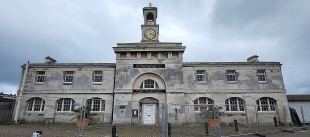
The Clock House was home to chronometers that were used to synchronise shipborne chronometers employed for determining longitude. The edifice stood on what was known as the Ramsgate Meridian Line, which was established in 1819. This was before 1851 when Sir George Airy (1801-1892) defined the position of the prime meridian that runs through the observatory at Greenwich. It was not until 1884 that the prime meridian at Greenwich was recognised internationally, much to the disgust of the French, who hoped it would run through Paris.
The now disused Ramsgate Meridian Line is east of the Greenwich prime meridian. So, when the clocks on the Clock House were set to Ramsgate Mean time, they were 5 minutes and 41 seconds ahead of GMT. A notice beneath the clock tower informs the viewer that the clocks are now set to show the same time as it is in Greenwich. And if there are any ancient mariners still using Ramsgate Mean Time, they are informed by another notice that:
“Ramsgate Mean Time is 5 min 41 sec faster than this clock.”
Whichever time you choose to use, it is well worth spending some hours, if not longer, in Ramsgate, which is full of interesting things to see as well as the Clock House.
July 29, 2023
Artists as artworks in London’s East End
BRICK LANE IN east London has been home to immigrants from various parts of the world. Currently, many of the people who live and work in the area are of Bangladeshi heritage. In the last few years, the area has attracted the ‘trendy’ set, whose interests are mainly in the attractions north of the former Truman Brewery. Some years ago, my friend David, visiting from Atlanta (Georgia), and I paid a visit to Brick Lane and were surprised to find a bit of ‘Ye Olde England’ almost hidden amongst the predominantly Asian businesses. It was the The Pride of Spitalfields London – a real old-fashioned ‘boozer’. Stepping into it, it was difficult to imagine you were not in a country pub, but in the heart of east London. It is on Heneage Street next door to what had once been part of a brewery.
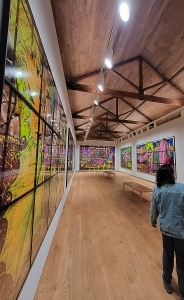
In 2015, the Trustees of the Gilbert & George Centre, a charity, acquired the building next door to the pub. On the 1st of April this year (2023), the converted buildings were opened to the public. They have been beautifully transformed by the SIRS Architects practice and they house artworks by the duo Gilbert and George (‘G&G’), who both trained at London’s St Martins School of Art. According to the G&G website (gilbertandgeorgecentre.org):
“The property was purchased with the idea to create a permanent home for works of the artist and to enrich London’s cultural offering thus further.”
G&G produce often very colourful works, all of which include the pair of creators within their images. As artists, they are also the subjects of their creations – they are almost always depicted in all their works. Their works deal imaginatively with a wide variety of things that we all face in our daily lives – some of them often considered too distasteful to be discussed or displayed. But G&G boldly bring them to our notice in a dramatic way. As Michael Bracewell, a Trustee, wrote on the website:
“Gilbert & George maintain an ideological opposition to formalistic art theory and the reference of art to the history or theory of art. Asserting instead the power of emotion and actuality, their art addresses subjects that are culturally excluded, neglected or disowned. Their art questions social taboos and morality. By looking at difficult subjects the art and vision of Gilbert & George is intended to ‘de-shock’ rather than seeking to shock. Its aim is not the simple task of ‘shocking’ a viewer, but the difficult task of interrogating a subject and themselves … Unchanging, they have the appearance and countenance of modern sober-minded, anonymous citizens, who have embarked on the astral journey of their own Divine Comedy: purgatory, Heaven and Hell as they find it and perceive it in our world, in nature and in themselves.”
Whether or not you like the creations of G&G, the new Centre is well worth visiting, even if only to see the fine design of the buildings containing it. If the art is all too much for you, you can pop into the pub next door and seek liquid relief. And if you loved the place, which we did, you can visit the boozer to celebrate the arrival of this superb new addition to the London art scene.
July 28, 2023
An artist and a gallery in a British seaside resort
THE GREAT BRITISH artist Joseph Mallord William Turner (1775 – 1851) was accurately described by the writer John Ruskin as “… the father of Modern art …” in 1843. Turner first visited Margate when he was aged 11. After about 1820, he often stayed in the town because he thought the skies over the area were the most beautiful he had seen in Europe. Between 1827 and 1847, he stayed in the town in a guesthouse owned by Mr and Mrs Booth. When Mr Booth died in 1833, Turner became a close companion of the widowed Sophia Booth, who died in 1878. He also adopted the name ‘Booth’.
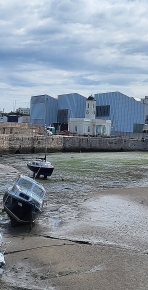
The house owned by Sophia Booth, where Turner resided, is no more. Where the guesthouse once stood is now occupied by the Turner Contemporary Gallery (‘TCG’). The gallery was designed by David Chipperfield (born 1953), and opened in April 2011. Just as Turner’s paintings were considered avant-garde and even provocative when they first appeared, the TCG is a highly adventurous contrast to the rest of the old town that neighbours it. Some buildings look better inside than outside. The TCG is a good example of this. The gallery spaces are spacious and well-lit both by natural and artificial light. They were a perfect place to view the highly colourful creations of the Brazilian born artist Beatriz Milhazes (born 1960), which are on show at the TCG until the 10th of September 2023.
I believe that the presence of the TCG has elevated Margate’s status from being a simple, unexceptional seaside resort to a place that attracts a much wider range of visitors than it did in the past. As happened in London’s Islington in the 1960s, a rather mundane place has become somewhere that people now feel they ‘must visit’. Although the usual British seaside attractions can still be found in Margate, the town is now also catering for the ‘up market’ clientele. And that cannot be a bad thing because when I lived in Kent (1982-1992), apart from Whitstable (and maybe Broadstairs), most of the seaside places in north and east Kent were in decline and rather melancholy.
The opening of the TCG has done for Margate what the art Triennale has done for another previously dreary Kent town – Folkestone. Even if Turner might have been shocked to see what now stands where he spent many happy hours with Sophia Booth, I feel sure that he would have been happy to know that it has revitalised a town which he loved.
July 27, 2023
Remembering victims of war in Sandwich, Kent
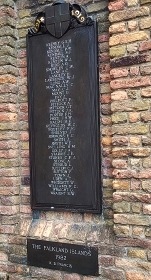
Some of the WW1 names and the Falklands victim below
IN THE HEART of Sandwich in Kent, near to the deconsecrated Church of St Peter, there is a war memorial that was erected to commemorate those from the town who died in the ‘War to End All Wars’ – the First World War (1914 – 1918). Roughly 100 names are recorded on the lists of people who died during WW1. However, they are not the only people listed on this monument because ‘The War to End All Wars’ did not live up to its name.’
The memorial lists about 15 people who were killed in WW2 (1939-1945). In addition, three of Sandwich’s population perished in the Korean War (1951), and more recently, one of the townsfolk was killed in the Falklands Conflict (1982).
I sincerely hope that no more names need to be added to this war memorial as a result of the conflict in Ukraine, or any future wars.
July 26, 2023
Safe and sound under the ground
DURING WW1, THERE were German Air raids over the town of Ramsgate in Kent. Many were killed by relatively few bombs.
In the late 1930s, the forward thinking Mayor of Ramsgate and his Chief Engineer designed a series of tunnels deep below the town to be used as air raid shelters. Over three miles of tunnels were dug into the chalk far below the town. The digging was carried out by miners from the (now closed) coal mines of East Kent.
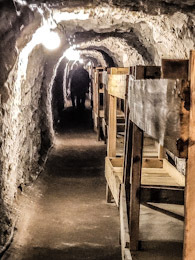 Bunks in the tunnel shelter
Bunks in the tunnel shelterExcept for a short section about 25 feet below the ground, which was reinforced with thick concrete, the rest of the tunnel system, which was on average 75 feet below the surface, was self supporting. The tunnels could accommodate up to 60000 people, but because many of Ramsgate’s population were either evacuated or serving inthe armed forces, the town’s population was about 15000 during WW2.
The tunnels were fitted out with electric lighting; bunk beds; benches; first aid stations; and chemical toilets. People were allowed to spend the night there or when air raids were in progress. Given that Ramsgate was the last place that German bombers flew over when returning to mainland Europe, they tended to drop any remaining bombs on the town. In addition, the Germans had heavy long-range guns at Cap Gris Nez just across the English Channel from Ramsgate, and shells capable of destroying buildings fired from these could arrive in the town without prior warning.
In short, the tunnel system saved innumerable lives. Today, excellent guided tours allow visitors to explore it. Today, the 24th of July 2023, we joined one of these tours. Everything was beautifully and interestingly explained. Although not as well furnished and comfortable as the huge nuclear bunker built at Gjirokaster in Albania in the 1960s, what was constructed in quite a hurry at Ramsgate is remarkable.
Having just seen the not too brilliant film “Oppenheimer”, I could not help wondering how many people might have been saved had Hiroshima and Nagasaki been supplied with deep shelters like that at Ramsgate.
July 25, 2023
Loads of lavender in rural Kent
ON OUR WAY to visiting new friends in Kent, at their recommendation, we stopped en-routr at Castle Farm near Shoreham. We were delighted to discover that this agricultural enterprise specialises in cattle and growing lavender. It is the largest lavender farm in the UK.
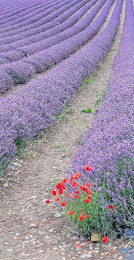
I had no idea until we visited the farm that lavender was grown on such a large scale in England. I have visited lavender farms in Provence and seen many glorious photographs of lavender fields in that and other regions of France. However, it came as a complete surprise to discover similar fields in South East England. I am grateful to Asha and Matthew for introducing us to this place.
July 24, 2023
A Northerner’s photographic images of the American south
THE PHOTOGRAPHER BALDWIN Lee, a Chinese American, was born in Brooklyn (New York) in 1951. He studied photography at MIT and then at Yale. In 1982, he was appointed Professor of Photography at the University of Tennessee, where he established the university’s photography course. As a New Yorker born and bred, he was amazed at the contrast between living conditions in the southern states and where he had come from. He began making tours of the south, photographing members of various African Americans at home, at work, and at play. Over the years he took more than 10000 photos. All of them are in the black and white format. Apart from being fascinating glimpses of the everyday lives of low income ‘black’ Southerners, they are beautifully composed, superbly detailed images – well worth seeing, as we did recently at the David Hill Gallery in London’s Ladbroke Grove.
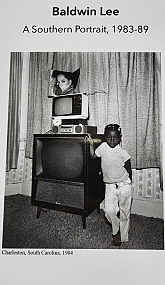
At his gallery, David Hill discussed Lee’s work with us. What particularly interested me was that Lee used (still uses) an old-fashioned field camera with a lens made before WW1. He chose this old lens because unlike modern lenses its glass has no coating. Also, and this is something I learned long ago, many of these older lenses were hand ground, rather than machine made. This resulted in the lens having a far better resolution than many of the best quality lenses that were available in the 1980s. The type of camera that Lee used to make his splendid photographs was not dissimilar to the kind of camera that early photographers such as Julia Margaret Cameron (1815-1879) used to create images. The lens on the simple camera that Lee used projects an image onto a ground glass screen at the back of the camera. In Victorian times, a prepared glass photographic plate used to be attached to the rear of the camera to capture the image. Lee, working more that 100 years later, captured his images on sheets of 5×4 inch high quality, fast negative monochrome film. Using these, Lee was able to create high resolution photographic images, and his subjects did not have to hold their poses for nearly as long as was the case when Cameron was creating her photographs. Because Lee’s subjects did not have to maintain their poses for more than a few seconds, his images are far clearer than Cameron’s whose subjects often had to try to remain still for many minutes. This meant that in addition to the deliberate artistic manipulations that Cameron made in her dark room, the inevitable slight movements that her subjects made added to the interestingly other-worldly images she created.
The advantage of using an old-fashioned camera and lens, such as Lee employed, was that it was a high-quality pin-hole camera. Unlike modern cameras, these present hardly anything that might alter the light entering the camera and affect the images. I found it fascinating that apart from taking advantage of the improvements in film quality this superb photographer prefers to use a camera that would have been familiar to Julia Margaret Cameron rather than a modern one that made the light entering it take a complicated path from the outside world to the film surface.
You can read more about Cameron in my book, which is available here:
July 23, 2023
Stepping forward in time
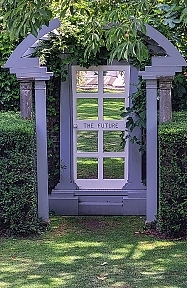
Step through the door
It will take you to the future
In a cosmic world
This door is in the garden of Charles Jenck’s Cosmic House in London’s Kensington

